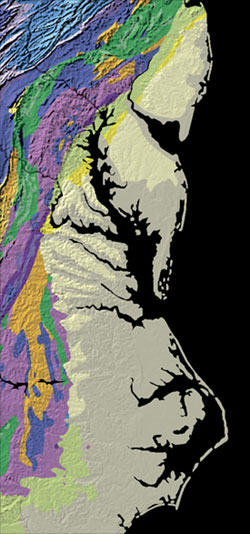
Atlantic Seaboard Fall Line
The Atlantic Seaboard Fall Line, or Fall Zone, is a 900-mile (1,400 km) escarpment where the Piedmont and Atlantic coastal plain meet in the eastern United States.[2] Much of the Atlantic Seaboard fall line passes through areas where no evidence of faulting is present.
The fall line marks the geologic boundary of hard metamorphosed terrain—the product of the Taconic orogeny—and the sandy, relatively flat alluvial plain of the upper continental shelf, formed of unconsolidated Cretaceous and Cenozoic sediments. Examples of Fall Zone features include the Potomac River's Little Falls and the rapids in Richmond, Virginia, where the James River falls across a series of rapids down to its own tidal estuary.
Before navigation improvements such as locks, the fall line was generally the head of navigation on rivers due to their rapids or waterfalls, and the necessary portage around them. Numerous cities initially formed along the fall line because of the easy river transportation to seaports, as well the availability of water power to operate mills and factories, thus bringing together river traffic and industrial labor. U.S. Route 1 and I-95 link many of the fall-line cities.
In 1808, Treasury Secretary Albert Gallatin noted the significance of the fall line as an obstacle to improved national communication and commerce between the Atlantic seaboard and the western river systems:[3]
Some cities that lie along the Piedmont–Coastal Plain fall line include the following (from north to south):